|
HOME: www.hiltonpond.org |
|||
THIS WEEK at HILTON POND Subscribe for free to our award-winning nature newsletter (Back to Preceding Week; on to Next Week) |
NATURE IN SPRING: The recent 12-day period--split between Hilton Pond Center and West Virginia--was punctuated by the arrival from Costa Rica of Ernesto M. Carman, our long-time guide and colleague on Operation RubyThroat hummingbird research expeditions to Central America.
All text, maps, charts & photos © Hilton Pond Center The 25th turned out to be a red-letter day, however, with an eye-popping assemblage of spring migrant birds showing up at one of our sunflower seed feeders. Along with the usual chickadees, titmice, and House Finches, we welcomed our first Rose-breasted Grosbeak (male above)--on the feeder tray at the same time as a male Indigo Bunting (below).
All text, maps, charts & photos © Hilton Pond Center As the rose-breasted departed he was quickly replaced by a male Blue Grosbeak (below) that munched side-by-side with the bunting before flying off with a seed in its bill.
All text, maps, charts & photos © Hilton Pond Center Blue Grosbeak males are sometimes confused with male Indigo Buntings, but the two rusty wingbars (above) of the former are diagnostic. Although both species nest in the vicinity of Hilton Pond, the Rose-breasted Grosbeak moves a little further north to breed.
All text, maps, charts & photos © Hilton Pond Center While we were watching these feeder birds there was also action in trees above, most notably a brilliantly hued Scarlet Tanager male (above) foraging for caterpillars in the subcanopy. He might stay to nest in the South Carolina Upstate but more likely was bound for North Carolina's mountains or even more northerly breeding grounds. Needless to say, these four species--the tanager, two grosbeaks, and a bunting--provided quite a rush and reminded us spring truly had arrived at Hilton Pond.
All text, maps, charts & photos © Hilton Pond Center On 26 April we saw no new migrants but managed to photograph a male Red-bellied Woodpecker (above) that was alternating bites between caterpillars and sunflower seeds. Note the aluminum band on his left leg--a sure sign he was a permanent resident at the Center. Much later that day we drove to the Charlotte airport to greet Ernesto, getting back to Hilton Pond in the wee hours of the 27th. After a short sleep he and the Hiltons were off for Fayette County, West Virginia and the 12th annual New River Birding & Nature Festival, based at Opossum Creek Retreat north of Fayetteville.
All text, maps, charts & photos © Hilton Pond Center Bright and early on the 28th we opened four mist nets in traditional sites we've used for the past half-dozen years or so, capturing birds for banding demonstrations while other guides wandered the property with Festival participants. Since nobody went very far, this first-morning event is traditionally known as "Birding by Butt." With Ernesto as scribe and net-tender, we caught several species to give our field birders a different sort of look at birds-in-the-hand.
All text, maps, charts & photos © Hilton Pond Center One of the first individuals we netted was a bright morph White-throated Sparrow (above), complete with well-defined head stripes, yellow lores, and--of course--a noticeable white throat. This species also occurs as a dull morph that contrary to popular belief is not an indicator of either age or sex. Interestingly, female white-throats of either morph appear to prefer dull morph males that turn out to be better providers; bright morph males continue to exist because they are better defenders of territory, so their genes also get passed on even if they aren't as attentive to their chicks. White-throated Sparrows winter in West Virginia but they all depart in spring for New England and most of Canada.
All text, maps, charts & photos © Hilton Pond Center Species banded at Opossum Creek on 28 April included three male Ruby-throated Hummingbirds; two each of White-throated Sparrow, Chipping Sparrow, Field Sparrow, and Hooded Warbler; and one each for male American Goldfinch, Gray Catbird, Wood Thrush, male Brown-headed Cowbird, male White-breasted Nuthatch, and female Red-bellied Woodpecker. A female Black-throated Blue Warbler confused quite a few observers--not surprising because even John James Audubon and other early ornithologists thought female (above) and male (below) black-throated blues were so different they must be separate species. The secret is to look for the pale spot at the center of the wing; it's present in both sexes (although very small in some females).
All text, maps, charts & photos © Hilton Pond Center After a fruitful morning of banding it was off to Hawks Nest State Park, where we gave a talk about hawk identification to a group of Road Scholars (formerly Elderhostel). These folks annually meet in conjunction with the New River Birding & Nature Festival and benefit from guides and other experts the Festival brings in.
All text, maps, charts & photos © Hilton Pond Center Tuesday was the Festival's first day for off-site field trips, which--after a mass breakfast--saw small groups in buses and vans dispersing to prime birding spots. This year, along with author Connie Toops, we led a stalwart assemblage of seven intensely interested birders (above) on a 90-minute ride up to Cranberry Glades in southern Pocahontas County--perhaps our most favorite spot in all of West Virginia. The glades are a series of mountain-top bogs filled with sphagnum moss and cranberries and vegetated around the margins with Speckled Alder, Red Spruce, and Yellow Birch. At 3,400 feet the site is high enough to mimic climate of locales much further to the north; thus, Cranberry Glades may be one of the most southerly breeding locales for Hermit Thrush, Nashville and Mourning Warbler, Northern Waterthrush, and Purple Finch.
All text, maps, charts & photos © Hilton Pond Center Our first stop was Cranberry Mountain Nature Center, operated by the U.S. Forest Service. Unfortunately, the center was closed that day, but very helpful volunteers there for a private meeting let us in to use the restrooms. They also allowed us to gaze out of the main observation window (above) that revealed what we already knew: The mountain was completely socked in and it was raining heavily. A hardy Ruby-throated Hummingbird male made occasional visits to a sugar water feeder but spent most of his time huddled up in the depths of a rhododendron shrub. We could see a solitary female Purple Finch perched in the rain on top of a shepherd's crook in the front yard.
All text, maps, charts & photos © Hilton Pond Center Other than that our outdoor observations were hindered considerably by the weather, so we spent some time observing and admiring a mounted Golden Eagle gazing down on us from a nature center alcove. Note the length of this raptor's deadly talons--surely the sign of a Rabbit Apocalypse.
All text, maps, charts & photos © Hilton Pond Center We had come too far to stay indoors regardless of blustery weather, so the group elected to drive a few hundred yards back down the mountain to Cranberry Glades itself. Wearing rain gear and toting folding umbrellas and binoculars, we ventured onto the boardwalk (above) in pursuit of birds. We heard few and saw almost none--not that we could blame the avifauna for hunkering down under such conditions.
All text, maps, charts & photos © Hilton Pond Center Cranberry Glades is a magical place at any time of year, but in the fog it took on mystical--almost primeval--properties. We could imagine Native American hunters standing in this very spot thousands of years ago, gazing across the sphagnum as they looked for Black Bears that still call this habitat home. We wondered if our predecessors were as impressed by the uniqueness of the glades, and if they were struck by eye-pleasing Marsh Marigolds (above)--the wetland's most colorful flora in late April.
All text, maps, charts & photos © Hilton Pond Center After an hour or so of getting colder and colder and wetter and wetter, the group gave up on birding and returned along the boardwalk to thaw out in the vans. From the Cranberry parking out we drove back down the mountain with the heaters full blast, stopping occasionally at picnic areas or trail heads to see what birds we could see or hear. We traveled slowly, knowing the vehicles carried precious cargo, each and every one of them already becoming a good friend. The lower we got the less rain and fog, so we did start to add to our bird list. By lunchtime we had a grand total of TEN species, probably the slowest start ever for an excursion during the New River Birding & Nature Festival--but everyone was still in great spirits.
All text, maps, charts & photos © Hilton Pond Center At one stop we listened for birds and marveled at a majestic but dying old American Beech (above) whose trunk was covered by Hoof Fungus, Fomes fomentarius, a very woody bracket fungus found across the Northern Hemisphere. The species' spores usually enter a tree through broken limbs or damaged bark, after which a parasitic root-like mycelium spreads throughout host wood--occasionally erupting to form the hoof-like fruiting body that releases more spores. Once a tree is dead, the fungus shifts ecological roles and lives on as a decomposer. This species is also known as "Tinder Polypore" because its soft, flammable wood can be used to start fires.
All text, maps, charts & photos © Hilton Pond Center Not far from the beech tree we could hear a male Black-throated Blue Warbler singing. After listening and looking for several minutes, we finally found him--seeking shelter from weather within the evergreen leaves of a low-growing rhododendron thicket. He eventually moved higher into the subcanopy, allowing a better view (above) of his big white wing spot--to say nothing of the black throat and blue dorsum that give him his common name.
All text, maps, charts & photos © Hilton Pond Center Just below the warbler was a wildflower new to us. Connie Toops recognized it as Broadleaf Toothwort, Cardamine diphylla (above), a native species found across much of eastern North America. Appropriately, it is a host plant for the eggs and larva of the West Virginia White butterfly, Pieris virginiensis. Its four-petaled cross-like flowers are characteristic of the Brassicacaeae, the Crucifer Family (AKA the Cabbage Family). Native Americans used this plant to treat incredibly diverse ailments from chest pains to hoarseness and tuberculosis to venereal disease.
All text, maps, charts & photos © Hilton Pond Center After descending another 2,000 feet the birding group continued its quest for more birds, eventually stopping at the Summersville reservoir. There we were astounded to see almost no birds despite one of the largest expanses of water in this part of West Virginia. We finally located an immature Red-tailed Hawk (above) perched on a short post as it eyed the terrain for possible prey. In the grassy area nearby a Killdeer was doing its broken-wing display, likely an attempt to distract the hawk from the Killdeer's nest.
All text, maps, charts & photos © Hilton Pond Center With about 90 minutes left until we were due back at Opossum Creek, we polled the group for what they wanted to do. "We vote for more birds" was the response, so we headed back toward Hawks Nest State Park (above). Hawks Nest, situated high above the New River, is in our judgment one of the most underused, underfunded, under-appreciated gemstones in West Virginia's state park system. Park property includes rich mixed woodlands that have recovered nicely from generations of mining and logging abuse . . . and you just can't beat the view of the New River Gorge from the lodge itself.
All text, maps, charts & photos © Hilton Pond Center Most visitors to Hawks Nest take a cable car from the lodge to the river bottom but our group drove down a winding gravel road that ended up near one of the river's many feeder streams (above). This was a whole 'nother world from Cranberry Glades and offered the promise of new bird species we didn't see elsewhere. There were swallows galore--Barn, Northern Rough-winged, Tree, and Bank--and lots of Baltimore Orioles singing high in trees along the riverbank.
All text, maps, charts & photos © Hilton Pond Center In shallow, slow-moving water near a boat landing we watched American Toads, Bufo americanus (above), in "amplexus"--during which the male climbs aboard a female, digs into her armpits with his thumbs, and holds on for dear life as he waits for her to produce a string of eggs over which he can broadcast his sperm.
All text, maps, charts & photos © Hilton Pond Center Amplexus can go on for days, which helps explains the presence of hundreds--nay, thousands--of little black tadpoles (above) swimming about in the shallows. We're not positive these particular tadpoles came from American Toads, but it was apparent at least some amphibians at Hawks Nest were doing a pretty good job of reproducing.
All text, maps, charts & photos © Hilton Pond Center After a long day the team departed Hawks Nest and headed back in for supper. We had shucked our raincoats (above) and were well satisfied with our 61 species --a respectable total for a birding day that started off with near-zero visibility, driving rain, and bone-chilling temperatures and ended up bright and sunny and full of good memories.
All text, maps, charts & photos © Hilton Pond Center The next morning (30 April) small groups headed out again on field trips, but we stayed behind with a few other guides for another "Birding by Butt" at Opossum Creek--this time for the Road Scholars. Again running mist nets and assisted by author Noah Stryker, we captured a nice assortment of birds, including a male Blue-winged Warbler (above) that had folks stumped for a few minutes. Note the yellow head and breast, the dark eye line, and the bluish wings with white wing bars.
All text, maps, charts & photos © Hilton Pond Center We also banded a bunch of "one-eachers": Male Ruby-throated Hummingbird, Chipping Sparrow, male Hooded Warbler, female Northern Cardinal--all of which were likely to breed locally--plus another White-throated Sparrow that would be moving north sometime soon. The breeding status of a male Magnolia Warbler (above) was less clear than some other migrant species at Opossum Creek. Like white-throats, most Magnolia Warblers nest in Canada but these parulids are known to breed along higher Appalachian ridges in West Virginia. This brightly colored warbler is easily identified even from below because of prominent white spots midway along its tail feathers.
All text, maps, charts & photos © Hilton Pond Center As participants departed on another set of field trips we celebrated May Day (1 May) by heading out alone to Wolf Creek Park between Oak Hill and Fayetteville; there, for the past five years, we've been designing and supervising installation of a boardwalk that meanders through a valuable 15-acre beaver-maintained wetland. Only 1% of West Virginia is bona fide wetland--there's plenty of water but it moves really fast from mountaintop to whitewater river--so it's important to preserve what wetland habitat remains. The Wetlands Boardwalk allows access by students and adults to an area that by its very nature is usually inaccessible, thereby providing first-hand opportunities to see how wetlands function in providing wildlife habitat and protecting water resources. There's always maintenance to be done on a boardwalk structure exposed to the elements year-round, so we spent the day re-nailing boards and adding to the handicapped accessible handrail system.
All text, maps, charts & photos © Hilton Pond Center That afternoon we eagerly awaited the arrival from upstate New York of old friend Dr. Jim Shuman, who we met 50 years ago in 1964 at the National Youth Science Camp over in Pocahontas County. Jim was traveling to West Virginia for a meeting in Charleston but wanted to take in a day and a night at the Festival to see what it was all about. (After all, he's heard us chattering about it for the past 12 years.) We stopped by the visitor's center for the federally protected New River Gorge National River and admired the view (above), discussing all the while the cultural and natural history of the region.
All text, maps, charts & photos © Hilton Pond Center Visible from the visitor center were branches of a towering Tulip Tree (above), whose leaves had been out for only a week. Each leaf blade was already riddled with holes--the work of legions of caterpillars that were the primary food source for migrant warblers and other birds as they arrived and--in many cases--stopped only temporarily in the Mountain State. The timing of bud burst, green-up, and leaf production is very important to local caterpillars, and is even more critical for birds that for millennia have arrived just when caterpillars are beginning to emerge. One real and frightening danger of global climate change--no matter its cause--is this precise timing will be thrown off, that caterpillars will emerge so early that migrant birds will not arrive in North America in time to capitalize on a historically dependable food source. Without warblers to keep caterpillars in check, ravenous larvae may defoliate the eastern hardwood forest and begin a spiraling decline that impacts on every living thing--humans included. Let's just hope Mother Nature can find a way to re-adjust; due to misunderstandings about scientific findings coupled with short-sighted political intransigence we don't seem to be offering her much assistance.
All text, maps, charts & photos © Hilton Pond Center On 2 May we went back out to Wolf Creek Park for yet another bird banding session and walking field trips with an amazing group of guides. We set our mist nets in four net lanes we'd used many times in the past several years and sat back to wait on captures, with Keith Richardson as net tender. Meanwhile, bird song experts Michael O'Donnell and Tom Stephenson set up shop in the parking lot, waiting for warming sun to strike the tree tops and activate the caterpillars that would, in turn, generate bird activity. No one was disappointed. As we listened to a Hairy Woodpecker drumming on a distant tree, another chisel-billed male (above) hit our nets for an up-close view of this black and white and red species. We didn't catch many other birds--male Hooded Warbler, Wood Thrush, and two Gray Catbirds rounded out the morning--but those few provided quality opportunities to talk about bird banding methods and avian adaptations. Besides, the trees were almost dripping with birds as the other guides including Rachel Davis busily pointed them out to Festival participants.
All text, maps, charts & photos © Hilton Pond Center Saturday, 3 May dawned as the final day of the Festival, and we were teamed again for the Sugar Creek field trip with guides Tom Stephenson and Scott Whittle--plus Ernesto Carman and Mark Garland. This particular excursion began at Ansted, wound up and then down gravel mountain roads, and ended on banks of the Gauley River. It was last year on this trip we finally got our lifer Cerulean Warbler, a "nemesis bird" that avoided us for far too long. Although we did spot a male cerulean back then, it was a long ways off and we always felt a little guilty we had done a "lifer dance" over an individual we could barely see though binoculars. This year as we got out at the first stop (above) the group scanned tree tops high overhead and listened hard for ceruleans and whatever other migrants might be around.
All text, maps, charts & photos © Hilton Pond Center The next stop happened to be at the same place where we got that lifer cerulean last year, so we anticipated seeing another this time around. We weren't disappointed in that regard and actually spotted three or four--one of which (above) was close enough to be photographed. Note the dark necklace of the male Cerulean Warbler; females are much paler, and both have rather short tails for a Wood Warbler.
All text, maps, charts & photos © Hilton Pond Center Although many participants come almost exclusively to see birds, it's worth remembering this is actually a birding AND nature festival, so one of our jobs was to point out flora and critters other than those with feathers. (Festival organizer and hard-core birder Dave Pollard refers to us naturalists and botanists as "weed pickers"; his wife Lynn is much more gracious in her appreciation for native flora.) The Sugar Creek road winds through hardwood forest in which there's plenty of rich soil, so wildflowers (and "weed pickers") do pretty well there. One of the showiest and most plentiful blossoms in early May is Star Chickweed, Stellaria pubera (above), one of nearly five dozen chickweed species in North America. Gardeners often look upon chickweeds with disdain, but we've always been enchanted by their little white flowers with five petals that are split, making it look like there are really ten.
All text, maps, charts & photos © Hilton Pond Center A wildflower group that everyone does seem to like includes Wild Ginger, Asarum canadense (above). All gingers have interesting flowers (called "pups") with three fused petals, but folks often miss seeing the blossoms; these form at the bases of the leaves and usually are hidden beneath leaf litter. In such inconspicuous places bees and butterflies couldn't act as pollinators, but beetles and various other terrestrial invertebrates do. (Incidentally, leaves of Wild Ginger are large and heart-shaped; the foliage at right in the photo above appears to be some sort of mint.)
All text, maps, charts & photos © Hilton Pond Center Another favorite of wildflower enthusiasts is Jack-in-the-Pulpit, Arisaema triphyllum (above), whose unusual inflorescence includes a spathe (pulpit) that surrounds a spadix (Jack) covered with tiny male and female flowers. Chemicals in this plant give off heat that, in combination with a fetid odor, attracts flies as pollinators. On the Sugar Creek trip we seem to find Jack-in-the-Pulpit only in roadside ditches rather than on slopes where many other wildflowers flourish.
All text, maps, charts & photos © Hilton Pond Center Nature lovers sometimes don't think of trees as wildflowers, but one can hardly argue that eye-pleasing blossoms of woody plants such as Yellow Buckeye, Aesculus flava (above) are anything but. This is the biggest of the native buckeyes, sometimes reaching 140 feet in height; it makes a great shade tree but is seldom planted by landscapers. Yellow Buckeye fruit--which resembles the eye of a male deer, or buck--contains a glucoside toxic to humans and livestock; it apparently is eaten with impunity by Eastern Gray Squirrels.
All text, maps, charts & photos © Hilton Pond Center Some spring woodland wildflowers bear leaves and blossoms well above the substrate, apparently an adaptation that allows them to photosynthesize and attract pollinators despite a thick layer of fallen leaves that carpets the forest floor. One example is the Common Yellow Violet, Viola pubescens (above) whose ten-inch-tall growth pattern is very different from ground-hugging violets that grow in more open areas. This is an important spring wildflower because it provides nectar for a wide variety of bees and flies, while its leaves become fodder for caterpillars of moths and Fritillary butterflies. Summer seeds are taken by Dark-eyed Juncos, Mourning Doves, and game-birds such as quail and grouse.
All text, maps, charts & photos © Hilton Pond Center For many woodland wanderers, trilliums are the quintessential spring wildflowers. Their name underlies their tripartite nature: Three leaves, three sepals, three petals, a three-sectioned pistil, and stamens in sixes (a multiple of three). One of the most common is Great White Trillium, Trillium grandiflorum (above), whose wavy-edged leaves and flowers are rather distinctive. The white petals sometimes turn pink just before they wither, leading unwary observers to think they're found some other species. (Caveat: Some local populations of this species always have pink petals.) Other than habitat destruction this plant's biggest enemy appears to be White-tailed Deer that show a marked preference for browsing on flowers and foliage. Curiously, deer select the tallest plants, leaving most short ones behind to propagate. Thus, the absence of tall trilliums is an indication of high deer density.
All text, maps, charts & photos © Hilton Pond Center As we moved along the ridge we observe Worm-eating Warblers, Ovenbirds, and Eastern Chipmunks and--almost directly overhead--another little cluster of Cerulean Warblers. We couldn't resist including another photo of a finely plumaged male that removed any hesitation we had about the species belonging on our life list.
All text, maps, charts & photos © Hilton Pond Center Eventually the ridge ran out and we began a gradual descent down Sugar Creek. Along the way we found several riparian wildflowers, including a thriving colony of perennial Wild Blue Phlox, Phlox divaricata (above), AKA Wild Sweet William. This species occurs naturally all across eastern North America to the Great Plains. It's interesting that plants in the Appalachians have flowers with notched petals while those in Missouri, Nebraska, and Kansas are unnotched. Phlox's faint perfume is a magnet for daytime bumblebees and butterflies and nocturnal moths; it is easy to grow and would be a great addition to most any backyard habitat.
All text, maps, charts & photos © Hilton Pond Center There also were new bird species along the stream, including a tail-bobbing Louisiana Waterthrush (above). Of the two waterthrushes--Northern being the other--Louisiana has a heavier body and a whiter, more prominent line above the eye. Both occur along streams and pond margins and seldom go high into trees. Note the long pink legs.
All text, maps, charts & photos © Hilton Pond Center Several small shrubs near where we saw the waterthrush had two-inch umbrella-like blossoms we recognized as Pawpaw, Asimina triloba (above). This bottomland shrub occurs colonially, forming a dense ticket--a "Pawpaw patch"--that restricts growth of other trees and shrubs. Pawpaw fruit is eaten by Opossums, Raccoons, foxes, and Black Bears, and was a popular desert for Native Americans and early settlers (including Thomas Jefferson). The flower's nectar is reminiscent of rotten meat, so pollination is typically via flies and carrion beetles.
All text, maps, charts & photos © Hilton Pond Center Our final destination for the field trip was where Sugar Creek flows into the Gauley River. This waterway, in turn, joins the New River to form the Kanawha, which feeds the Ohio, which joins the Mississippi--putting the Gauley in the watershed of the Gulf of Mexico. (Some rivers in eastern West Virginia feed the Potomac, which flows into Chesapeake Bay and the Atlantic Ocean.) Huge boulders jutted from the Gauley River and its sandy beach (above); when we departed this beach was much cleaner due to the thoughtful and industrious litter-picking of our group. In the background of the photo above you can see a rail line that carries coal trains; an invasive, purple-flowered Royal Paulownia tree grows at upper right.
All text, maps, charts & photos © Hilton Pond Center After a sumptuous picnic lunch--complete with tables and tablecloths--the group worked this riparian site pretty intensively for warblers, occasionally playing a tape of bird song and listening for a response (above). Guides and participants alike are encouraged to be judicious with taped calls, lest overuse interfere with the daily lives of birds already on territories.
All text, maps, charts & photos © Hilton Pond Center While listening for birds it was impossible not to notice at our feet a vast bed of Dwarf Crested Irises, Iris cristata (above). This six-inch-tall native spreads by rhizomes, usually in moist habitats.
All text, maps, charts & photos © Hilton Pond Center In near-monoculture the Dwarf Crested Iris makes a spectacular display, but individual flowers (above) can be just as breath-taking.
All text, maps, charts & photos © Hilton Pond Center As our Saturday field trip came to an end, the 2014 Sugar Creek Gang of Five (above) posed for an iPhone selfie: Expert guides (left to right) Bill Hilton Jr., Ernesto Carman, Mark Garland, Tom Stephenson, and Scott Whittle. "Bird calls and weed-picking our specialty."
All text, maps, charts & photos © Hilton Pond Center This year's New River Birding & Nature Festival included more than 100 participants--plus three dozen Road Scholars--with 25 expert guides from across North America (and Costa Rica). Most days at least six field trips took folks to unique and picturesque West Virginia habitats at the height of spring migration. Bird banding sessions provided opportunities to see those all-important field marks from a different perspective, and botanical experts pointed out the interdependence of plants and birds and other animals. As the 2014 Festival came to a close, the Hiltons and Ernesto headed back for South Carolina to refresh hummingbird feeders and see what migrant birds might still be moving past Hilton Pond Center. A few warblers remained, but most had already gone north--perhaps to spots where we saw them the preceding week in the West Virginia mountains.
All text, maps, charts & photos © Hilton Pond Center On 4 May, however, sharp-eyed Ernesto sighted a couple of distinctive raptors swooping and diving over open fields adjoining the Center's wooded property. There was no question these graceful creatures were adult Mississippi Kites (above and below), grabbing insects as they flew. We were quite surprised to see kites--only our second local record since Russ Rogers Jr. spotted an immature one below our pond 30 years ago on 2 August 1984; that late summer bird represented post-breeding dispersal. It was especially unusual to have Mississppi Kites here so late in the spring because they nest primarily in South Carolina's Sandhills and Coastal Plain--not in the Upper Piedmont. It's possible what we saw with Ernesto was a breeding pair extending the species' breeding range.
All text, maps, charts & photos © Hilton Pond Center Alas, 'Nesto had to return far too soon to his home at Finca Cristina, so we made another Charlotte airport run on 5 May--bidding him adios until our next Operation RubyThroat expedition to the Chayote fields of Ujarrás in November. Down there in Costa Rica we'll undoubtedly capture and band some of those same Neotropical migrants that filled the trees during our eventful and enjoyable week in West Virginia.
All contributions are tax-deductible on your |
|---|
|
"This Week at Hilton Pond" is written and photographed by Dr. Bill Hilton Jr., executive director of Hilton Pond Center for Piedmont Natural History.
|
|
|
Please refer "This Week at Hilton Pond" to others by clicking on this button: |
Comments or questions about this week's installment? Send an E-mail to INFO. (Be sure to scroll down for a tally of birds banded/recaptured during the period, plus other nature notes.) |

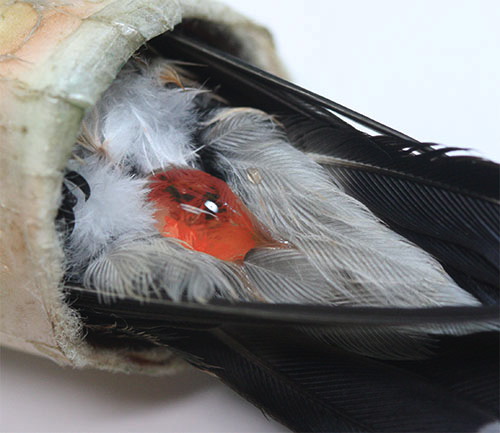 From 22-25 April we mostly dealt with supervising the next step of a major kitchen renovation in the Center's old farmhouse, a room that has been essentially unchanged for more than 65 years. We took time to celebrate Earth Day on the 22nd, keeping in mind our personal mantra that "Every Day is Earth Day!" We marveled at the far-reaching power of Facebook when our photo of red-tinged urine produced by a hummingbird
From 22-25 April we mostly dealt with supervising the next step of a major kitchen renovation in the Center's old farmhouse, a room that has been essentially unchanged for more than 65 years. We took time to celebrate Earth Day on the 22nd, keeping in mind our personal mantra that "Every Day is Earth Day!" We marveled at the far-reaching power of Facebook when our photo of red-tinged urine produced by a hummingbird 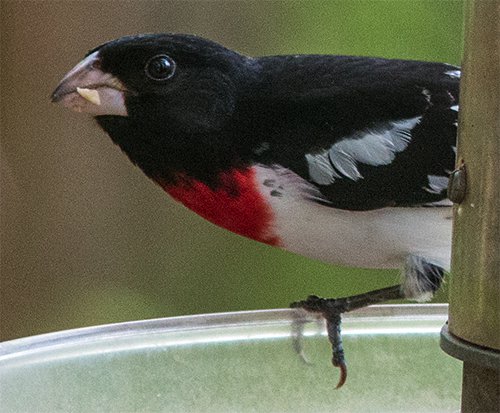
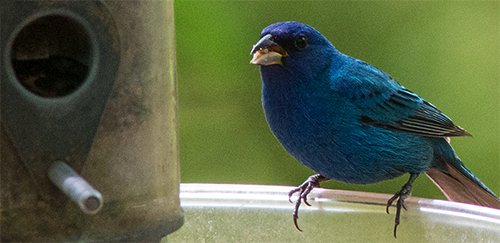
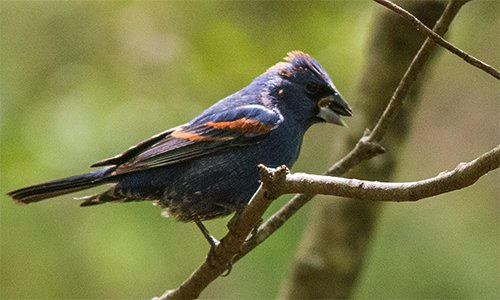
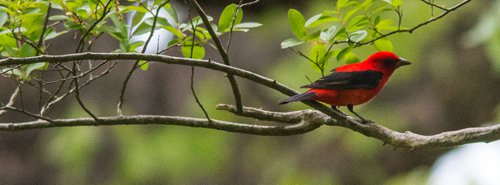

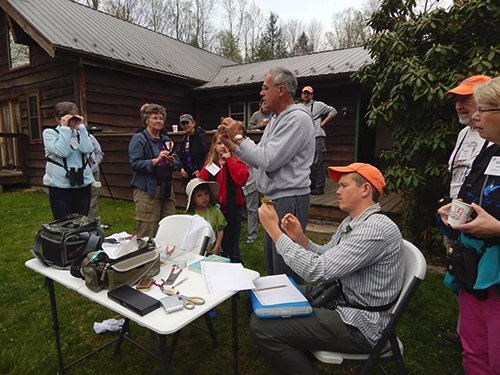

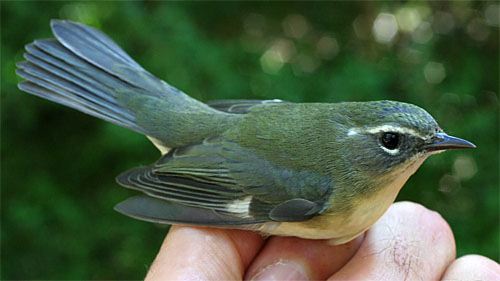
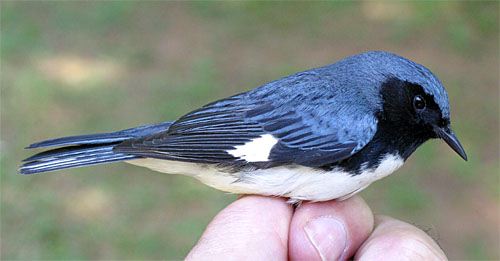

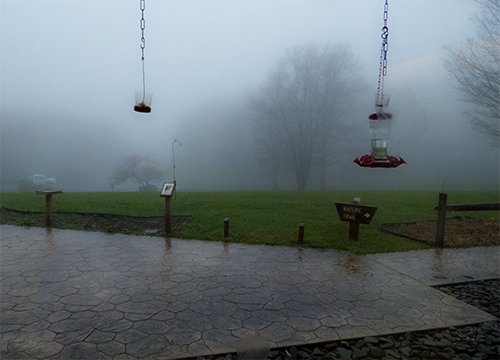


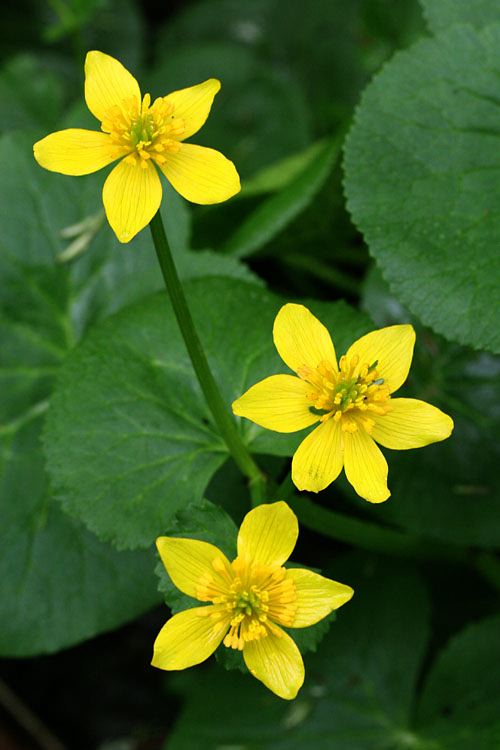
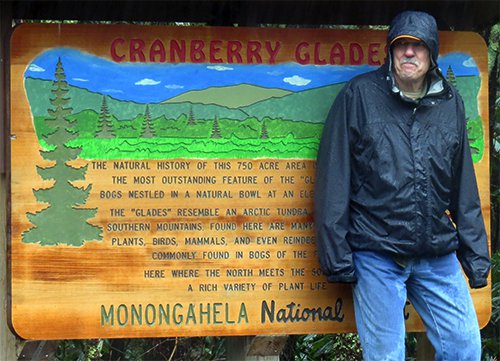

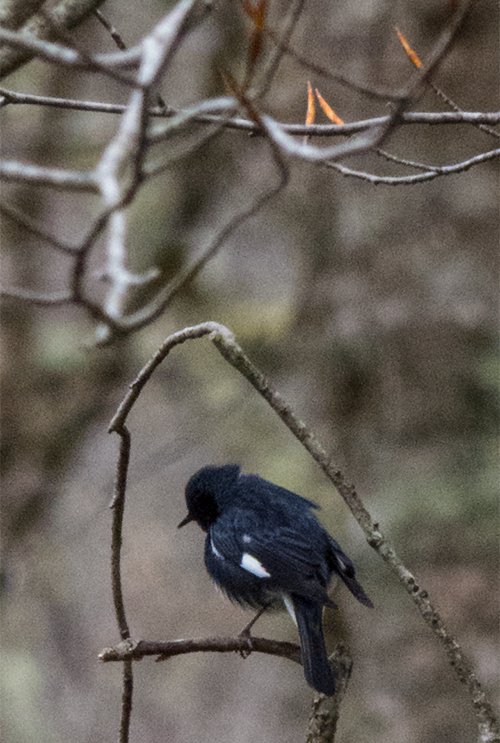
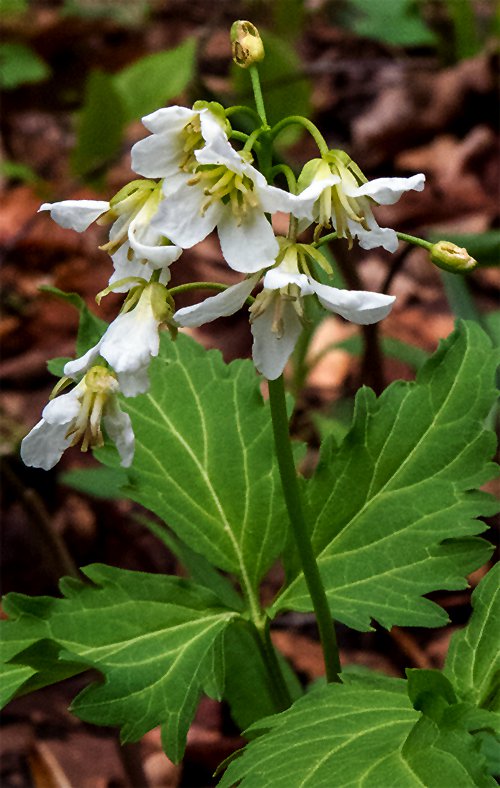



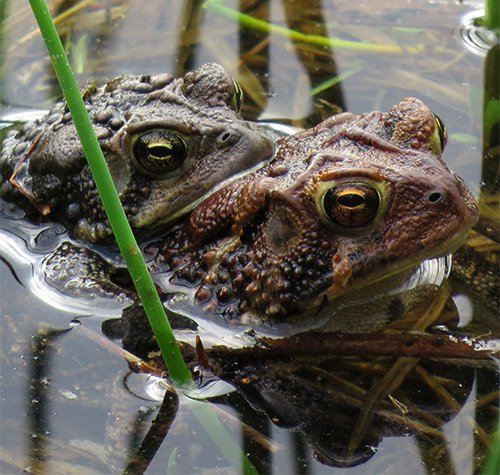

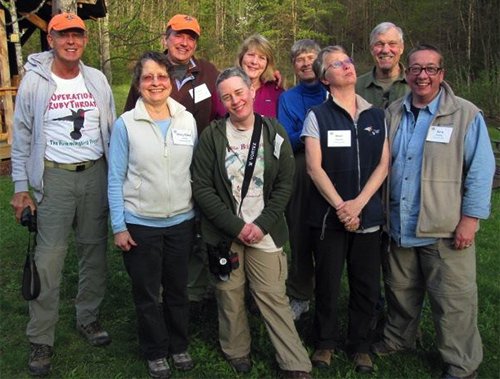



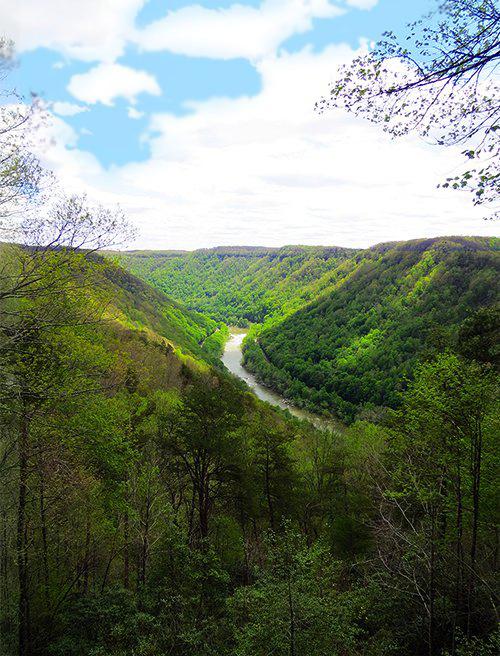
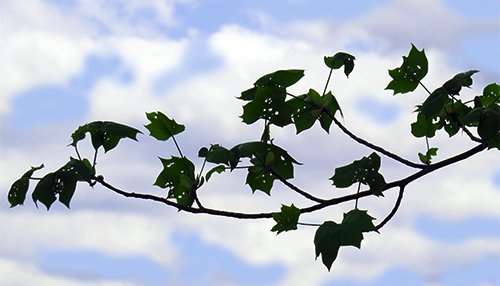


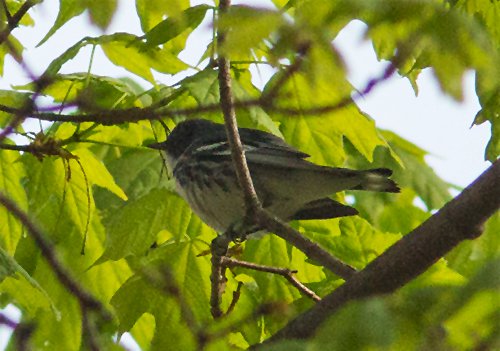
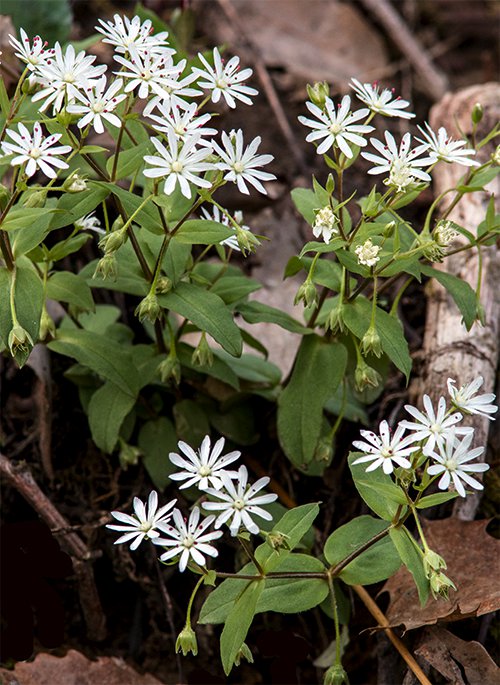
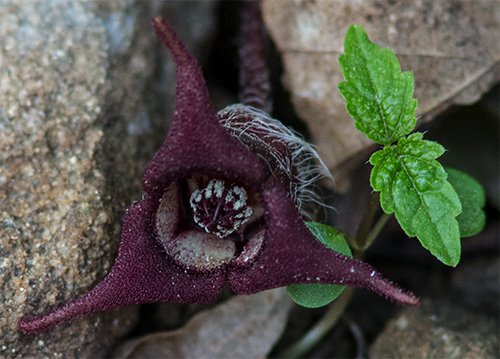
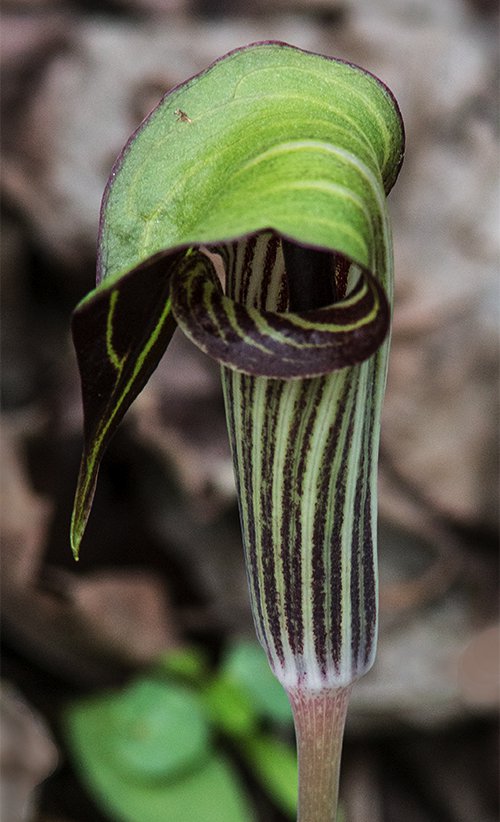
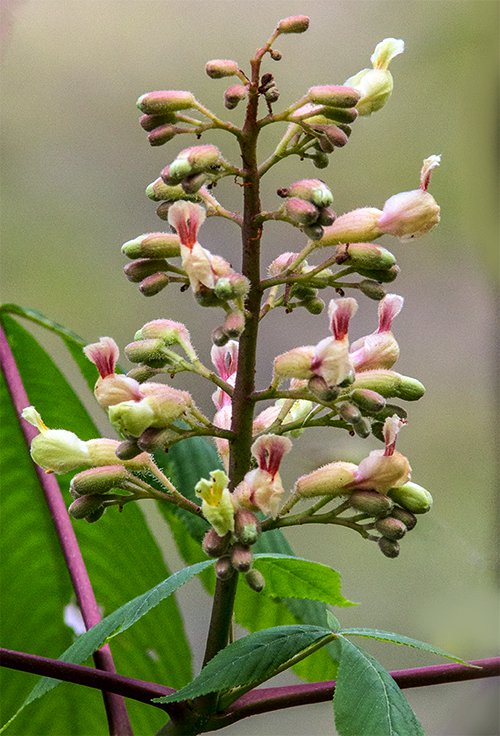

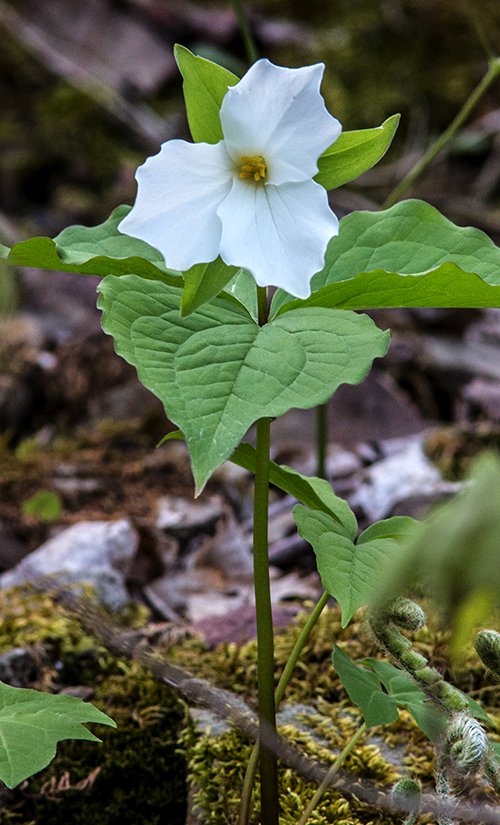

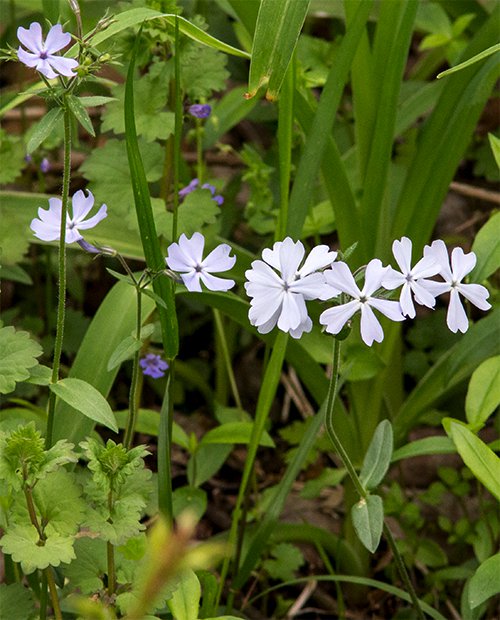
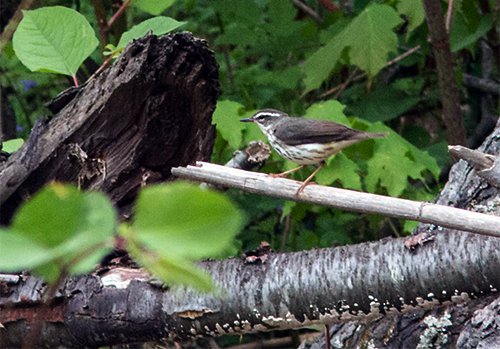


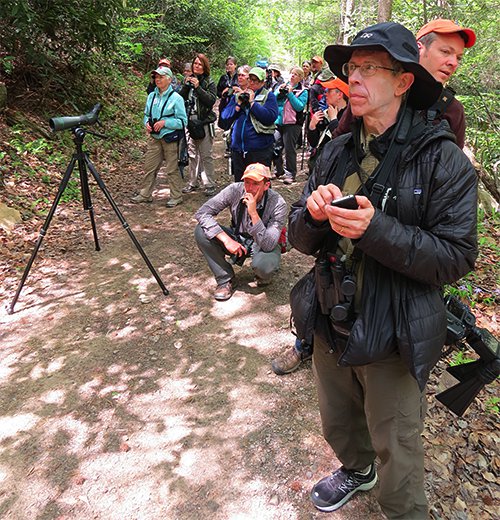
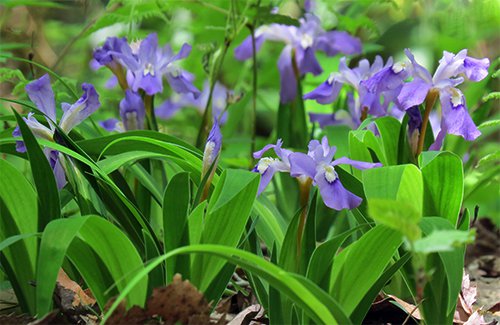
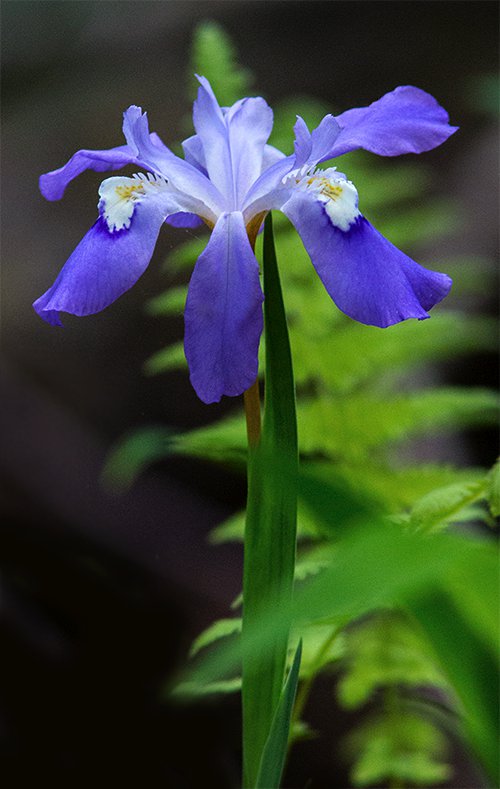
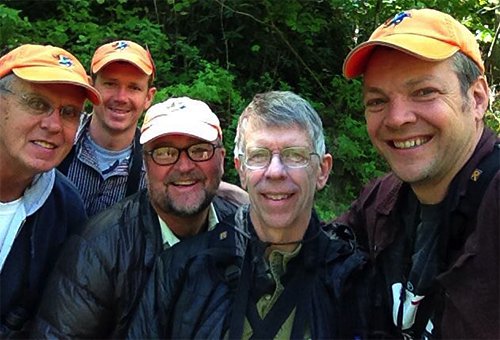

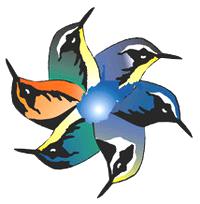 Afternoons included "popcorn" lectures by guides or other speakers, followed by evening talks about everything from moth ecology to geriatric albatrosses to differentiating warbler songs. We don't know for sure how many bird species were observed during the week--the Festival philosophy is to provide quality looks without concern for quantity--but it certainly was well over 100; that was enough to make all the folks in the drone's-eye-view above happy with what the Festival had to offer.
Afternoons included "popcorn" lectures by guides or other speakers, followed by evening talks about everything from moth ecology to geriatric albatrosses to differentiating warbler songs. We don't know for sure how many bird species were observed during the week--the Festival philosophy is to provide quality looks without concern for quantity--but it certainly was well over 100; that was enough to make all the folks in the drone's-eye-view above happy with what the Festival had to offer. 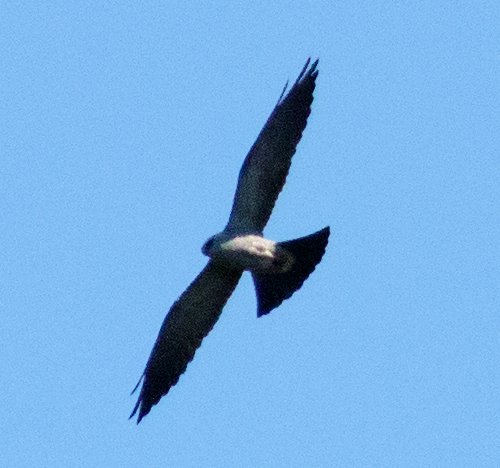
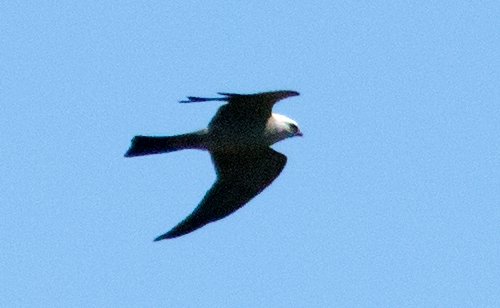








 Please report your
Please report your